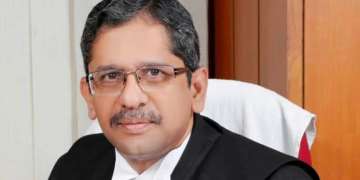Mediation an important conflict resolution mechanism: Chief Justice N V Ramana
Mediation, which was commonly followed in India prior to the arrival of the British and their Court system, is now one of the most vital conflict resolution mechanisms which will continue to grow in relevance in the coming future, Chief Justice of India (CJI) N V Ramana said on Thursday.

Mediation, which was commonly followed in India prior to the arrival of the British and their Court system, is now one of the most vital conflict resolution mechanisms which will continue to grow in relevance in the coming future, Chief Justice of India (CJI) N V Ramana said on Thursday.
He said that not only did the British establish the framework for the modern Indian judicial system, but they were also instrumental in the creation of the myth that dispute resolution and justice requires black coats and gowns and elaborate arguments.
“It is time to dispel such myths and notions. The reality is most of the litigants in India suffer from many social and economic constraints. What they need is a quick, inexpensive and convenient method of dispute resolution.
“Mediation is one such mechanism available to parties to a dispute which has the above mentioned characteristics. Apart from the fact that it is cost effective, time saving and convenient to parties, there is another facet of mediation that marks it out as perhaps a better alternative for parties,” Justice Ramana said.
“I believe that mediation is one of the most important conflict resolution mechanisms currently which will only continue to grow in relevance in the coming future,” said the CJI, who was speaking at International Virtual Mediation Summer School, 2021 organised by Supreme Court trained mediators -- “NIVAARAN”.
Highlighting the importance of mediation, the CJI said apart from the fact that this process is cost effective, time saving and convenient to parties, there is another facet of mediation that marks it out as perhaps a better alternative for parties.
While noting that mediation was a practise that was commonly followed in India prior to the arrival of the British, Justice Ramana said traditional litigation often leaves one of the parties to the proceedings dissatisfied with the result, which is why parties sometimes appeal decisions all the way to the Supreme Court.
“This often compounds the problem of judicial delays. This is an outcome of the “winner-takes-all” attitude that has come to affect the system,” he said adding that mediation solves this problem.
The CJI said that mediation signifies a shift from an adversarial attitude or position and creates an atmosphere that focusses on better outcomes for all parties.
It enables parties to contemplate a continued relationship after the end of the resolution process, he said adding that an important facet of mediation that is often not emphasised enough is its possible contribution to improving access to justice in the country.
“Pursuing traditional litigation strategies can often be difficult for parties without ample resources or time or sophistication. Mediation, as a tool of grievance redressal which is cheaper, faster and simpler, can ensure just and fair outcomes,” he said.
Highlighting the role played by the top court, the CJI said it has played an active effort to improve mediation in India and has played a crucial role in bringing mediation into the mainstream.
Various judicial pronouncements by the Supreme Court of India have, among other things, resulted in the creation and spread of Court annexed mediation in the country, he said.
The CJI said the Supreme Court Mediation and Conciliation Project Committee, which was set up in 2005, has been integral when it comes to the training of Mediators in India.
He also flagged some issues regarding the difficulties that mediators face during conflict resolution.
The first issue related to the role of a Mediator- which is now shifting to a more active, engaged role as opposed to the facilitative role which was earlier envisaged, and how a Mediator must act in such situations.
The second, relates to what a Mediator must do, or how “neutral” a Mediator must be, in the face of a patently unjust settlement reached between parties in unequal bargaining positions, he said.
The CJI said that such issues require a Mediator to be well trained and equipped to understand and be prepared to react to any situation that arises before him.
He said this can only happen if there is a well-designed training programme for Mediators in place with a focus on situation recognition and the appropriate response.
The Supreme Court Mediation and Project Committee has already created a model Training Programme wherein 40 hours of training and participation and successful completion of a certain number of mediations is mandated for accreditation as a qualified mediator, he said.
"Training should also take place periodically and continuously. We should also be innovative and think of how new technologies and ideas can help in improving the training," the CJI said.
Emphasising the role of law schools and their curriculum, the CJI said while the Bar Council of India mandates a course on Alternate Dispute Resolution, more focus should be placed by law schools in the country on clinical education, with a focus on Mediation.
Earlier on July 17, CJI had said that projected statistics that pendency in Indian courts has reached 45 million cases, which is perceived as the inability of the Indian judiciary to cope with the caseload, is an "overstatement" and an "uncharitable analysis" and one of the factors contributing to judicial delays is "luxurious litigation".
READ MORE: CJI says judiciary can't be controlled or else 'rule of law' will become illusory - Top Quotes